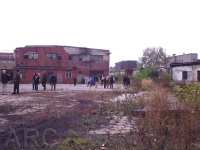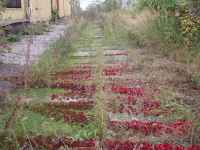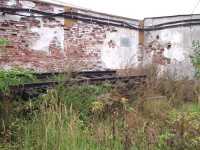 |
| Umschlagplatz in 2004 |
About 26,000 Jews were deported to the death camp in
Belzec
between 17 March and 11 April 1942 from the Lublin ghetto.
They were all taken from
the gathering point in the Great Synagogue on
Jateczna Street in the centre
of the ghetto, and had to walk a distance of 4-5 km to the ramp which was
located near the town slaughterhouse, a modern factory built in Lublin in
1927.
The ramp had been used solely for industrial purposes until the time of the German
occupation. The building and the ramp were hidden from the view of the inhabitants
of the city. Even Polish employees who worked in the slaughterhouse were not able
to see the details of the deportation, because the ramp was surrounded by the
walls of the factory buildings and by barbed wire.
 |
| Former Slaughterhouse in 2004 |
According to Polish employees who worked in the slaughterhouse at that time,
only the screams of hundreds of people and the firing of machine guns could be heard.
Trains carrying the deportees departed early every morning. On occasion, some
trains stood at the ramp for 2-3 days and from the overcrowded cattle cars the
screams and cries of the imprisoned people could be heard. There were no bodies
of the people who had been shot to be seen, since the corpses of those killed at the
Umschlagplatz were loaded into the cattle cars together with those deportees still
alive and awaiting transport.
Rumours about the fate of the Lublin Jews who had been taken to the
Umschlagplatz
were spread by Polish railway workers. These told of the many people who had been
killed or already died in the trains there. Some Jews tried to break free from the
Umschlagplatz, attempting to hide in the slaughterhouse, but there was no escape for
them. As a military organization producing meat for the German army, the factory
was under the supervision of the
Wehrmacht. Everybody working there was strictly
checked by German soldiers and policemen. During the time of the deportations, the
buildings of the factory were subject to especially rigorous inspection. Anybody
attempting to escape was arrested and once again taken to the
Umschlagplatz.
There is no testimony available from anybody who escaped from the
Umschlagplatz.
During post-war investigations and trials, even the SS men who were responsible for
the deportations from the Lublin ghetto failed to provide any details about this place.
 |
| Former Ramp in 2004 |
 |
| Memorial in 2004 |
The location was totally forgotten after the war. Only in the last several years
a group of people from Lublin started to discuss the commemoration of the site.
In
1990, a modest memorial was built at the
Umschlagplatz – a symbolic railway
ramp and a memorial plaque were dedicated.
The entrance to the site is still restricted (
2004). The Lublin
Umschlagplatz is located on the grounds of the former slaughterhouse factory which subsequently became
bankrupt. Anybody wishing to visit the site requires permission from the liquidator of the factory.
All of the surrounding buildings are derelict and nobody cares for this place.
The liquidator of the meat company has agreed that the
Umschlagplatz should be
commemorated in a suitable manner. He is prepared to discuss the possibility of
selling the site to somebody who would create a more appropriate memorial.
Today, only a few individuals in Lublin know that there was an
Umschlagplatz for the
Lublin ghetto and for its Jews, the first victims of
Aktion Reinhard.
© ARC 2005












